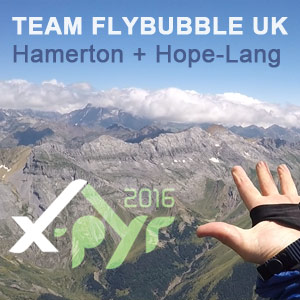
X-Pyr is a race along the length of the Pyrenees mountains, which divide Spain and France. It alternates with the Red Bull X-Alps race for the title of toughest paragliding event of the year. Contestants must carry their paraglider (or fly with it). The course is 480 km, the race starts at 05:30 and ends at 22:30 every day, and lasts about a week. Flybubble team pilot Greg competed in the 2016 edition supported by his friend James.

Preparation
I trained as hard as I could for over half a year, walking every morning (10km), doing weekly runs with a bag (20km), and doing bodyweight exercises. I was in the best physical shape I'd been for years. I did some big distance flights in the mountains early in the year, many 100km flights in the UK and did the Bornes to Fly race in Annecy a few months before. I bought maps, studied the land on Google Earth, loaded hiking trails on my phone. I was as ready as I could be. What was missing? Peak ascent training, and resistance to the heat. You can probably spot the problem.
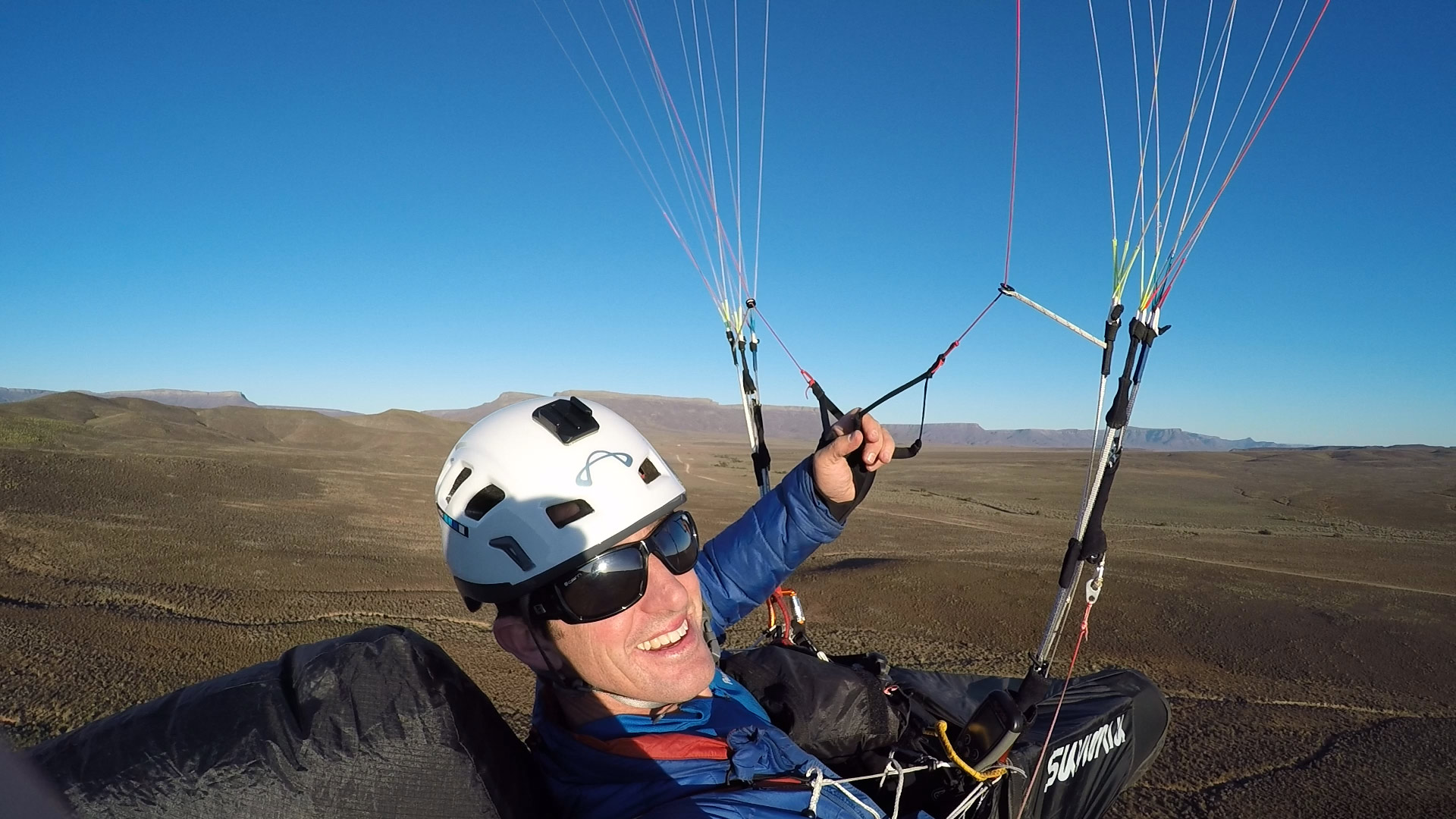
Training in the South African desert
A few weeks before the start, disaster struck! Our team campervan was written off and the driver, Captain Carabiner, withdrew. As he was in charge of jokes, we had a sense of humour failure. I bought a newish Citroen C4, large enough. At least it was French so it should cope with the French motorways, but I was worried it might die in the Spanish heat. It wasn't the car that I should have been worried about.
Equipment

Aah, snow. That will be shorts and T-shirt weather for me then...
Advance Omega XALPS 22
Skywalk Range XALPS
Skywalk Hike 55L backpack
High Adventure Beamer 3 Light
Syride Sysnav V3
Icaro Fly helmet
Supair Touch gloves
Mini Compass
Flytec Tracker
Delorme Tracker
Sunglasses
Pacerpoles
Hiking boots
Hiking shorts and shirts from Izas
Outdoor Research sun hat
Advance down jacket
Basic first aid and glider repair
Water purifaction tablets
If rain likely:
Marmot waterproof jacket
Waterproof pants
Gaitors
Pack cover
Depending on the section:
Water (up to 3 litres)
Snacks (lunch plus a few bars)
USB Battery charger
My pack weight varied from 8kg to 11kg.
Course overview

Start - TP1 Larun
It's going to be hot, at midday, in midsummer, with a pack. There's 18km of road to get out of the way. The best way to do this fast, is to run. If you've ever tried running with a paraglider on your back, you'll know it's a bad idea. There's no way to avoid the impact on your knees, the heat buildup in your feet, and the strain that means tomorrow morning will be sore. But TP1 Larun is close to the sea, so once the land heats up, the seabreeze can rush in, killing any hopes of getting high. Getting to the hill late might mean lots more walking after a short flight. There's a steep 800m ascent to launch, so expect those with running talent and mountain legs to surge ahead.
TP1 Larun - TP2 Ohri
Who can get over as much of this bitty hilly forested terrain as possible, under the coastal inversion layer? Expect weak climbs to less than 1000m. Expect many relaunches. Every kilometre closer to TP2 improves the chances of getting to the proper XC conditions, and flying away. So pilots will be going hard on Day 1. Keep your eyes on Michal Krysta, who led the XPYR 2014 for the early part of the race.

TP2 Ohri - TP4 Pena Montanesa
Ridge-soaring the border between France and Spain. Haha. If only. I think the dominant airflow in this section is a northerly wind that pushes stable marine air over the mountain divide, and it can be strong. 2014 saw some insane launches near the turnpoint. Most of everything is covered in forests. The sort of coverage that means you can't see any landing until you're above it. I really want to be high here. It might be an advantage to swing out south into Spain, to avoid the French air. It can be hard to find a relaunch point in this terrain without a significant ascent, so making a flight last all day is crucial. I'm fairly confident in this section: I feel at home once I'm on the Spanish side of the Pyrenees, which has a similar energy to the Western Cape mountains of South Africa. My role model for this leg is Aaron Duragoti, who completely aced this section in the 2014 edition, with committed lines and PWC style racing speed. Except now, he's got another 2 years of experience under his belt. Good luck to anyone wanting to keep up with him.
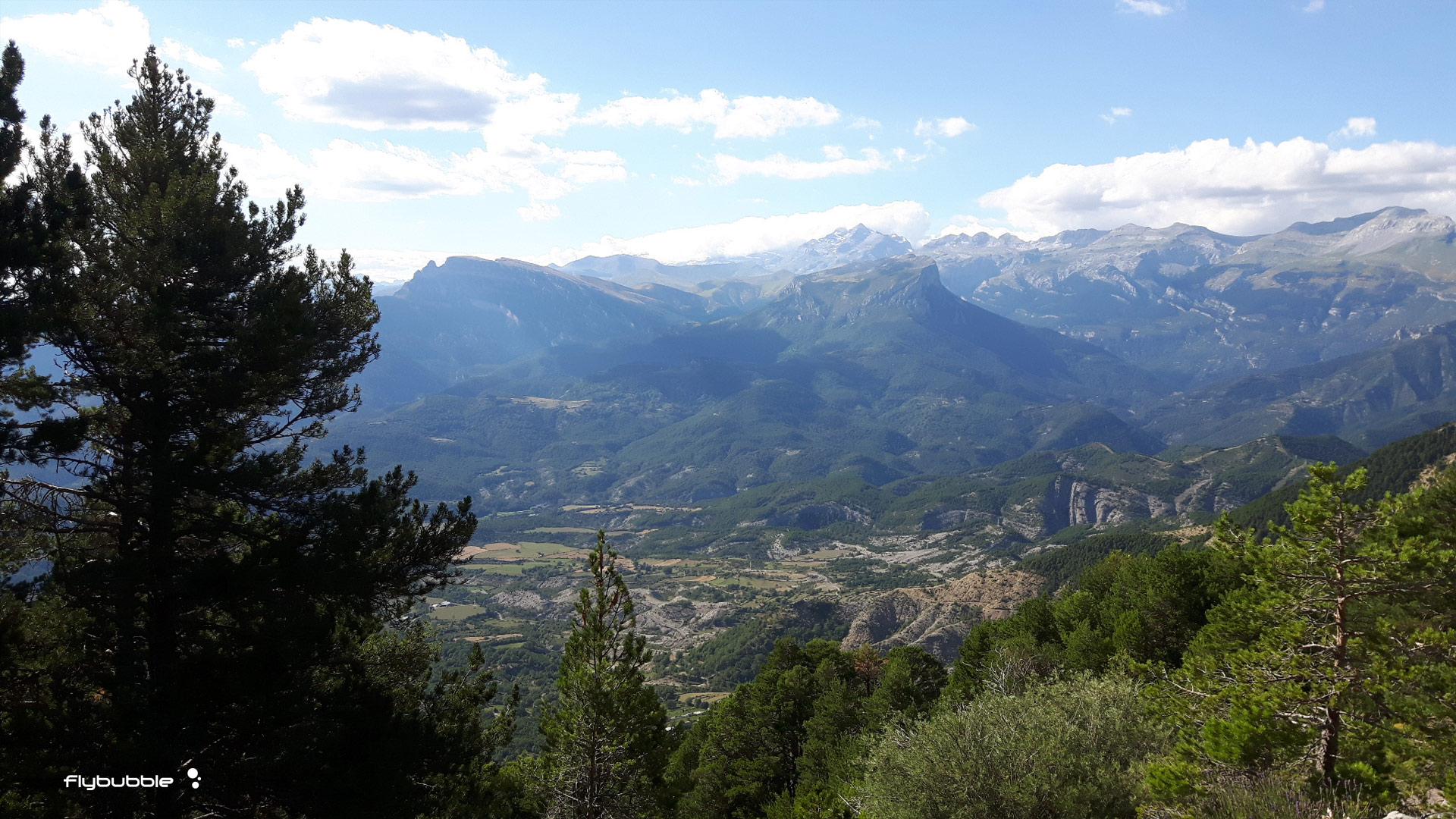
TP4 Pena Montanesa - TP5 Cecire
The crux move of the whole course, in my opinion. Going from Spain up the narrowing valleys leading to a 3000m+ ridge line blocking the way into France. I expect if the conditions are good enough to fly over this divide, they're close to blowing up with thunderstorms. The winds converge from both sides of the Pyrenees here. Those pilots who have to walk this due to low cloudbase or excessive wind are going to take on some pain and lose a day over those who fly it. I'm going to be really focused on playing this move at the right time. Expect Chrigel to show his mastery of mountain flying here.
TP5 Cecire - TP6 Bergueda
We're whipping through these turnpoints, but the reality, on the ground, is that this is brutal. There's a very very long way to go here, most of us will be exhausted from pushing too hard, and any missed flying opportunities will hurt. Fatigue, body damage, dehydration, frustration, team politics, sun exposure, logistics, vehicle issues, power management, map reading and general loss of enthusiasm might play bigger roles now than flying skill.
TP6 Bergueda - TP7 Canigo
This section alone would be enough of a challenge. Whenever teams touch down and have to fight their way forward on the ground, they will be reduced to a snail's pace. The roads don't follow this route. The mountains are big. The sun is hot. The legs? They don't work anymore. The good news is, the flying should be downwind; but climbs are deteriorating, and winds can be changeable here. I think Spanish locals like Inigo Gabiria and Ivan Colas have an advantage here, due to their experience of flying near Castejon. Also I expect the fit young Jedis like Jesse Williams and Juraj Koren to be a significant threat at this point as well as X-Alps pros like Lars Budack, Stanislav Mayer and Gerald Gold whose experience at endurance eventing will begin to show. Of course there's probably a certain Swiss pilot dabbling his toes in the Med by this point, but that just adds to the tension as the 24hour countdown is ticking.
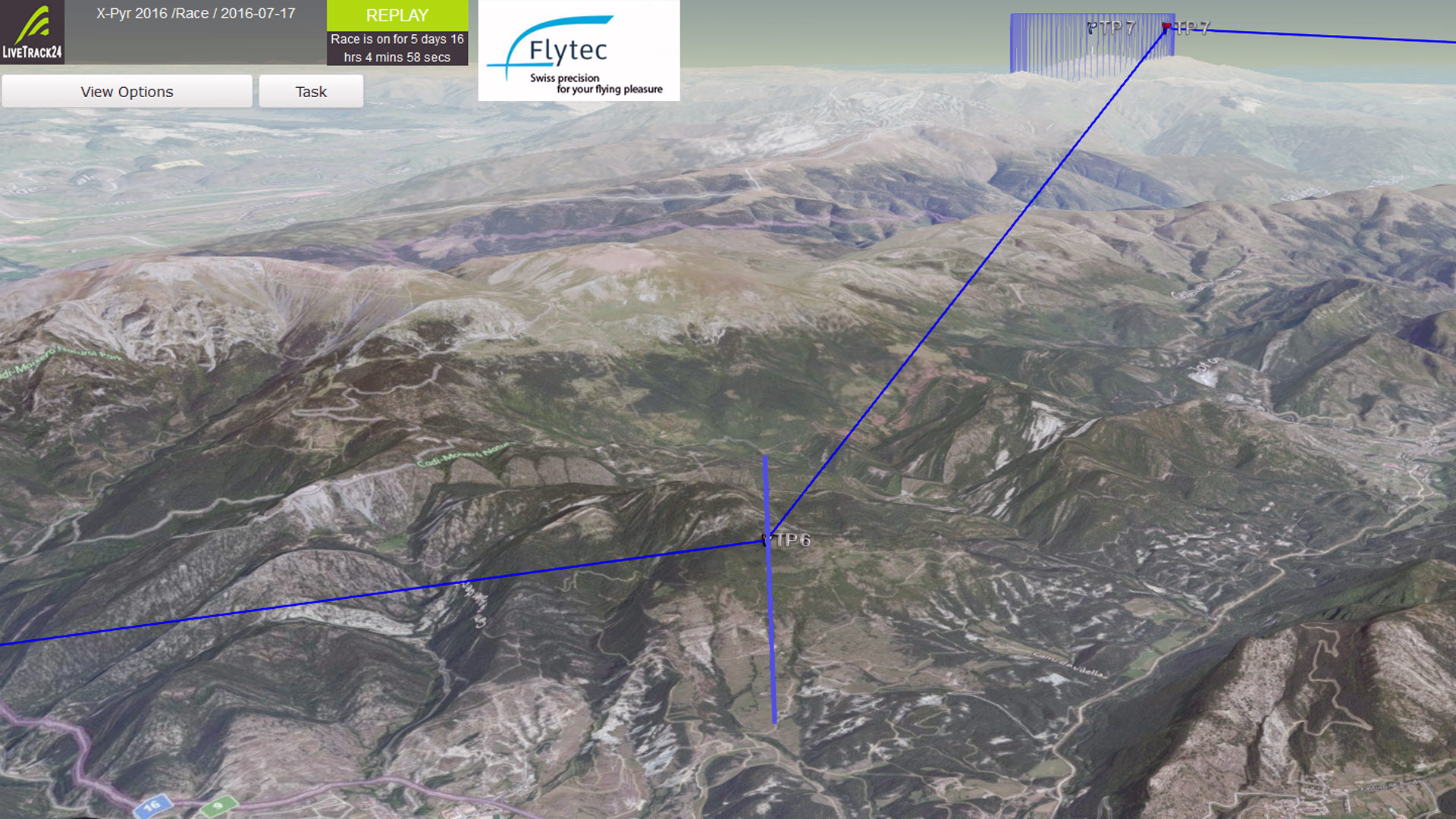
TP7 Canigo - TP8 Santa Helena de Rodes
The sting in the tail. There's cloudy French air spilling in from the north, climbs are deteriorating, wind direction shifts, and there's some airspace near the end. This can be flown around, if you swing wide, risking further walking if you land. Again, the roads don't line up with the route, which follows the hiking trails GR10 and GR11 more than anything else. A clever move in this section could see some exciting last-minute podium assaults from the mid-field.

TP8 Santa Helena de Rodes - Goal
Unforgettable. Everyone who gets here is a winner. Everyone who doesn't deserves a standing ovation. Right, let's do this!
XPYR Race: Day 1
Finally, the days of preparation and briefings are over, the handshakes are done, the drones are flying, and we're counting down to the 11:00 start gun. There's a sudden rush of activity as the rookies see Maurer in his plastic bags, and scurry around tying last-minute sand protectors on their shoes for the 'glory dash' off the beach. I'm wearing hiking boots so it doesn't bother me.

Yes, that little pimple in the distance is the mountain we must run to.
We're off, and I choose a steady pace near the front of the pack. I've trained for the 18km run/march, although it's tougher in the heat than I'm prepared for. I do OK, most pilots are nearby when I reach the carpark at the base of Larun, but I'm 40 minutes behind the leaders.
It's now 13:30 and the heat is building. At my car, I rest, eat and drink for 20 minutes. It doesn't help much: when I begin the ascent, I rapidly overheat. I have no strength for the climb and I have to stop for regular shade and water breaks. "My race, my pace," I've decided. Keep the motivation high, enjoy the adventure. Besides, the information I've received from the top is that nobody is getting up, only sled rides are happening, there's no hurry. This was not entirely accurate, but I didn't question it as it was what I wanted to hear. At my leisurely pace it takes 3 hours from the bottom to the top, about 2 hours slower than the strongest pilots. Yes, the heat slayed me.
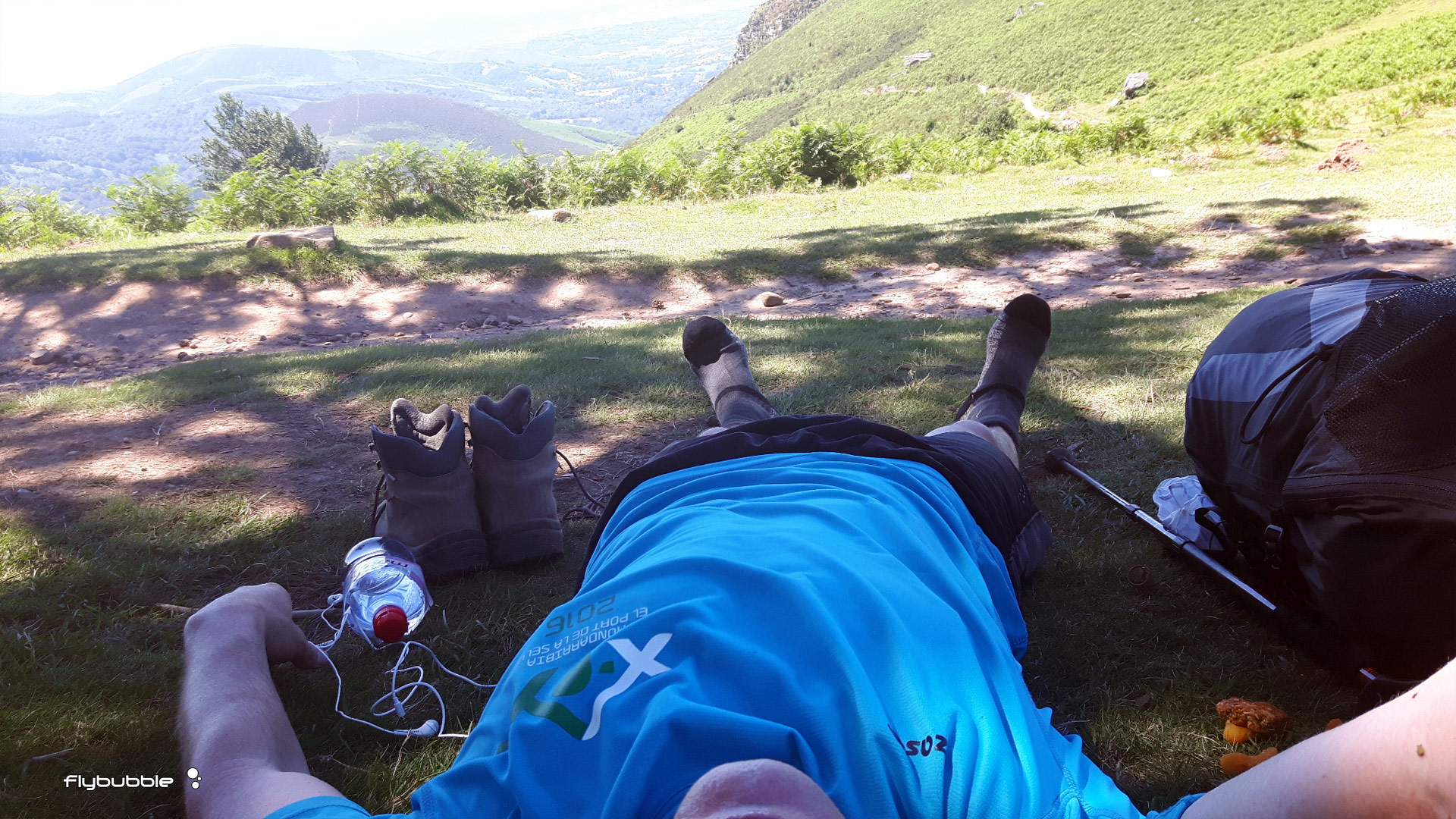
It's not the XPYR it's the EXPIRE
In fact Durogati reached the peak at 13:46 with Maurer close behind. They rest and launch 45 minutes later, along with Mayer. Krysta and Williams launch too, but bomb out. Maurer follows the low ridge east, gets a good climb, glides over to the pass, gets flushed on the south side and lands. Mayer and Durogati topland on the ridge above Maurer. They all walk on to the high peak overlooking Erratzu.
Back at Larun, half the pilots who glide off end up at the bottom of the first big hill facing a stiff ascent to get into the air again. Half scratch and scrape up to peak height before following the leaders, who are by now hiking east on the high ground. Williams relaunches and leads a small group who dive over the back and find a leeside saver.
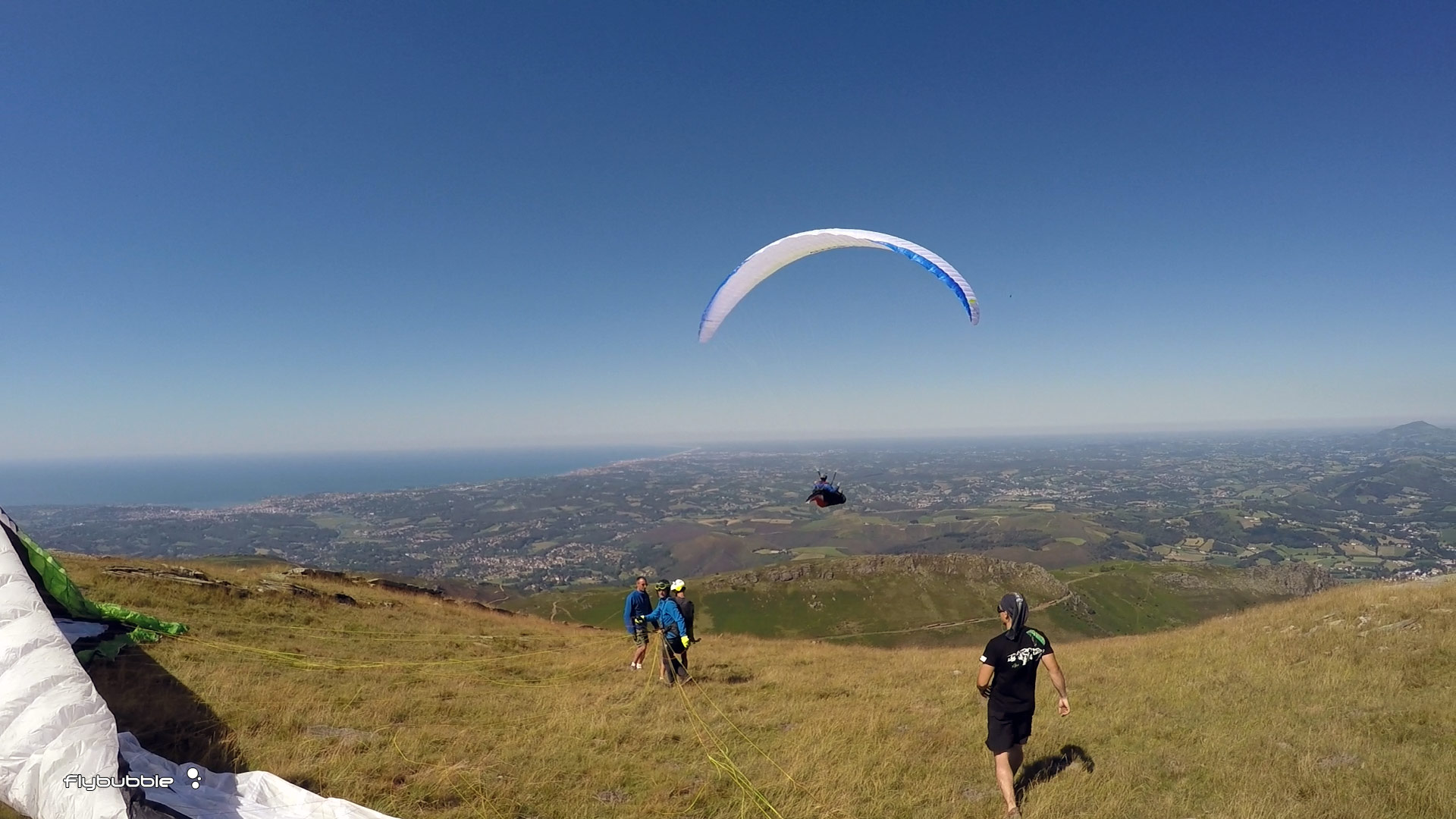
I launch after 17:00 and have a short glide with no thermals. After hours of gruelling hiking, there's more gruelling hiking. This start day is really full on, in your face, extreme. The horse flies continue to work on me, and the sun beats down. Keller and Gold have just climbed above the next peak inland to 1300m but by now the front ridge is weak and it's hard to even get to peak height.
At 17:30 Maurer Durogati and Mayer (let's call them the leaders, they'll remain close together) relaunch. The chase group all lands in the valley behind them. Williams launches a third time and does some good patient thermaling to land before Col du Ispeguy. The leaders advance to the hills south of St Jean Pied a Port, a 10km lead.
They fly together down the Piedaport valley, land together near Caro, which has a straight road link along the course line, run 10km together, and camp together near the base of the Cols d'Iraty pass. Watching their tracks I'm struck by how efficiently they move, very close to the course line.
Williams hikes over the Col du Ispeguy and glides into the St Jean Pied a Port valley to join the 'chase group'. Juraj glides in with one minute to spare. It's a decisive split: all those past the col will fly on the south of the big mountains tomorrow.
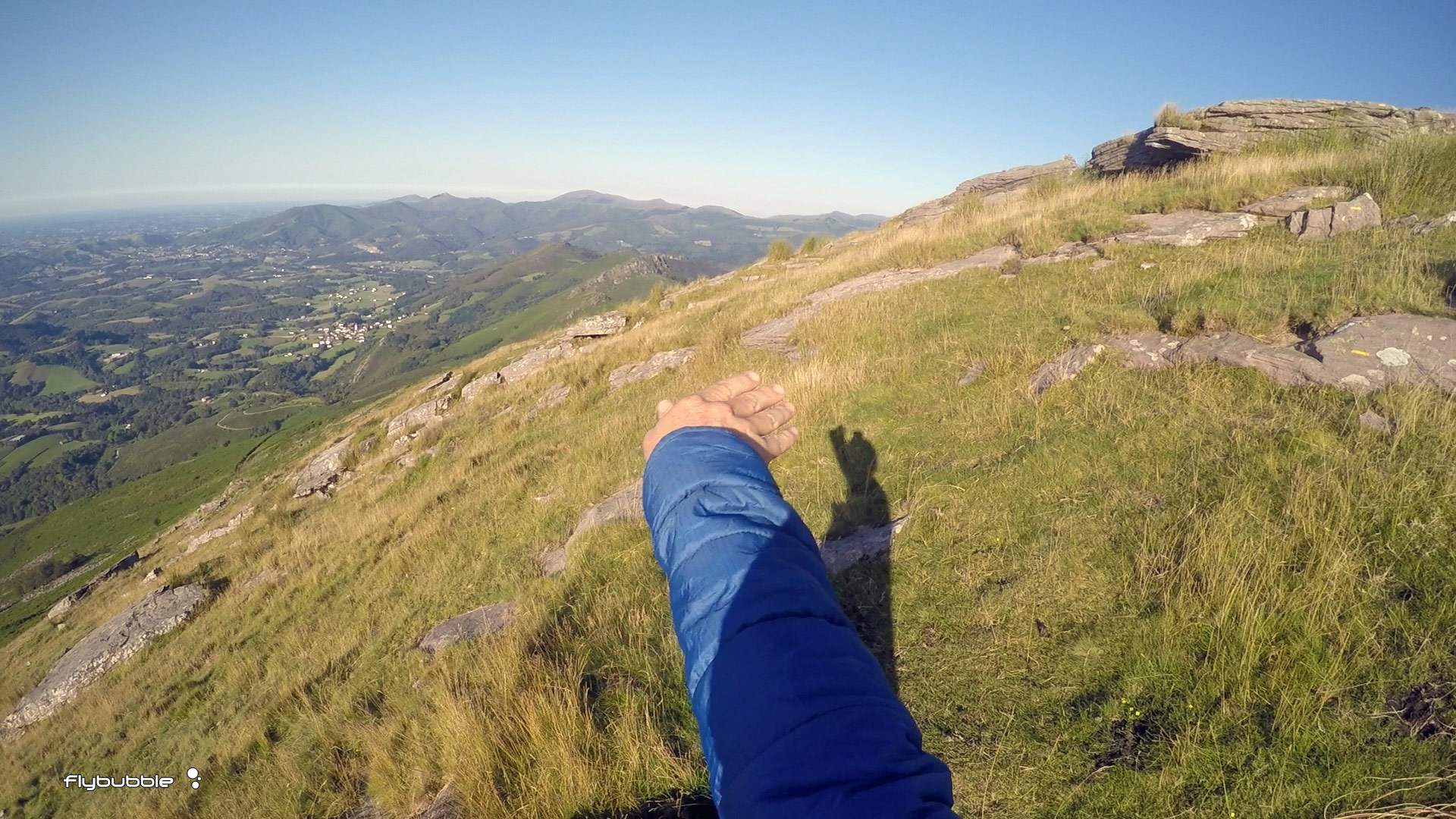
I'm about 25km behind the leaders, on the hill overlooking the quarry. I launch and dive over the back; a short glide and walk sets me up nicely for the morning. Gliding is sublime; the breeze washes over me. There are a few pilots scattered along the front ridge who I have sneaked past, but I've got a lot of catching up to do. By the time I go to bed, the leaders are 37km ahead.
Hiking: 29km with 1415m ascent
Flying: 8km (2 flights)
XPYR Race: Day 2
04:30 alarm clock! It's pitch dark, so getting prepared takes some time. I'm a bit late to start but not in any particular hurry, as I am only allowed to fly down from 07:00. I walk in the fading dark and launch at dawn for a quick glide down. I'm the only early flight, everyone higher is blown out, I walk the cool valley to the col, about 10km and 500m ascent.

Meanwhile Juraj Koren scales a big hill, launches and has a long glide past St Jean Pied a Port. (There are two Korens, so to avoid confusion I've called them Juraj and Zlatko).
At 10:00 I reach the col, and hear that Ivan Colas is being taken away to hospital. He's crashed launching in the switching winds. Winds aloft are strong S; the col links two east-west valleys. Many pilots are gathered nervously around the col, waiting to fly. I've caught up some positions.
An hour later Budack, Garza and Petz fly down to St Jean Pied a Port, catching Ludwig who has walked down. I wait till 12:00 for better thermals, climb nicely and fly against the strong headwind to the first peak (5km) so I can walk around to the better launch for improved conditions in the afternoon. I'm not going to make headway flying against such strong southerly.

The race is on to reach the south side of the range. Maurer and Durogati then Mayer reach Ohri (TP2), and by 12:30 they are thermaling in strong wind. They go along the ridge to Belagua, forward to Izaba, and blaze off on the big mountain line. For almost 2 hours they are the only ones in the air, opening up a gap in peak flying time.
At 14:00 after more than 35km on foot in 8h30 (and 2000m ascent) on a day with 34 degree temperatures, Guede launches from Ohri, and chases the leaders, making good progress. He gets stuck at Anayet (TP3) for over half an hour, soaring just below peak height with the turnpoint agonisingly close, just over the back. Then at last, he gets a thermal and can tag the cylinder getting up to 3200m before a long glide to near Biescas where the valley wind stops him at 19:00. Excellent flying, and that 66km flight establishes him firmly in fourth place.
But that's well short of the lead gaggle. At 17:20 Maurer went through Pena Montanesa (TP4) cylinder, with Durogati and Mayer hot on his heels. Maurer has timed it perfectly. He's jumping to higher peaks late in the day, everything has heated up well, he gets to over 3800m and makes the crux crossing to Cecire easily.
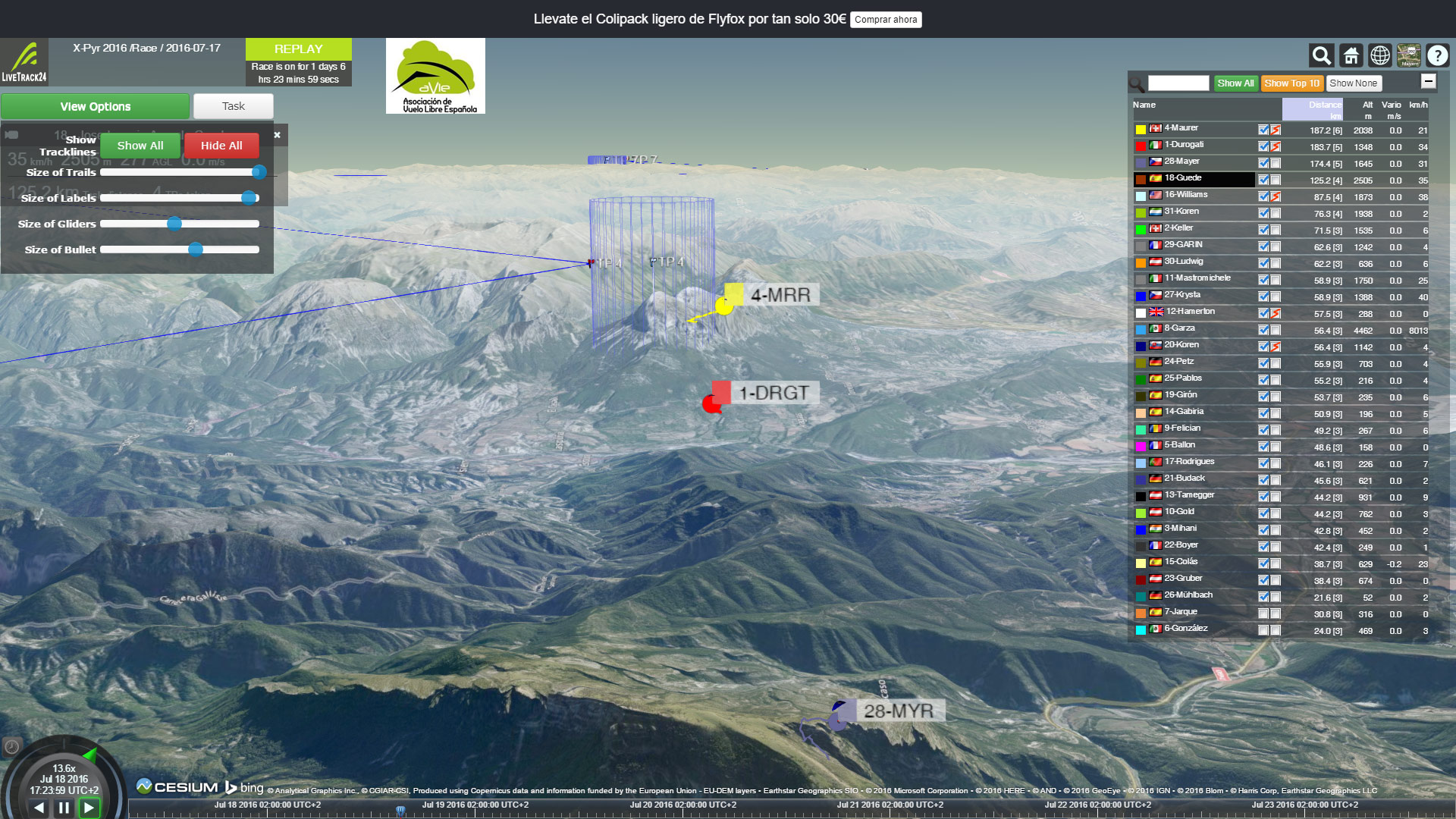
He opens a gap during this transition, and although the others make the crossing in similar style, Chrigel stays in the air after the other two and frisbees down the valley to land and camp high on a pass. Durogati toplands and hikes over to fly down the south side, a risky move that goes at right angles to the course line but puts him further into the (good) Spanish air and a morning launch at the reliable XC base of Castejon de Sos.
Back in the midfield, at 16:15, some chase flying begins. Krysta and Mastromichele have hiked from Col du Ispeguy the whole day south (almost 30km) a bold ambitious gamble which pays off big time. They fly off the ridge above Roncesvalles, climbing to 2000m. They get low at times, Krysta lands, relaunches, and struggles, but Mastromichele works it all the way to Ohri. Then he flies till almost 21:00 and almost Turnpoint 3! Another decisive 66km.
Williams launches from Ohri and takes a committed line deep in the mountains to link up with the Rio Subordan valley, skirting the edge of the forbidden airspace of the national park and landing high for a late hard hike to Candanchu ski station. He's in fifth position.
Zlatko launches from a clever peak south of Esterencuby and toplands Ohri before continuing on a more conservative line that gets him near the Rio Subordan valley. Mastromichele tries something different for this piece, pushing forward of William's line to work the big peaks and fly around on the south side, but he gets stopped by the final ridge line that prevents him getting to the Canfranc valley.
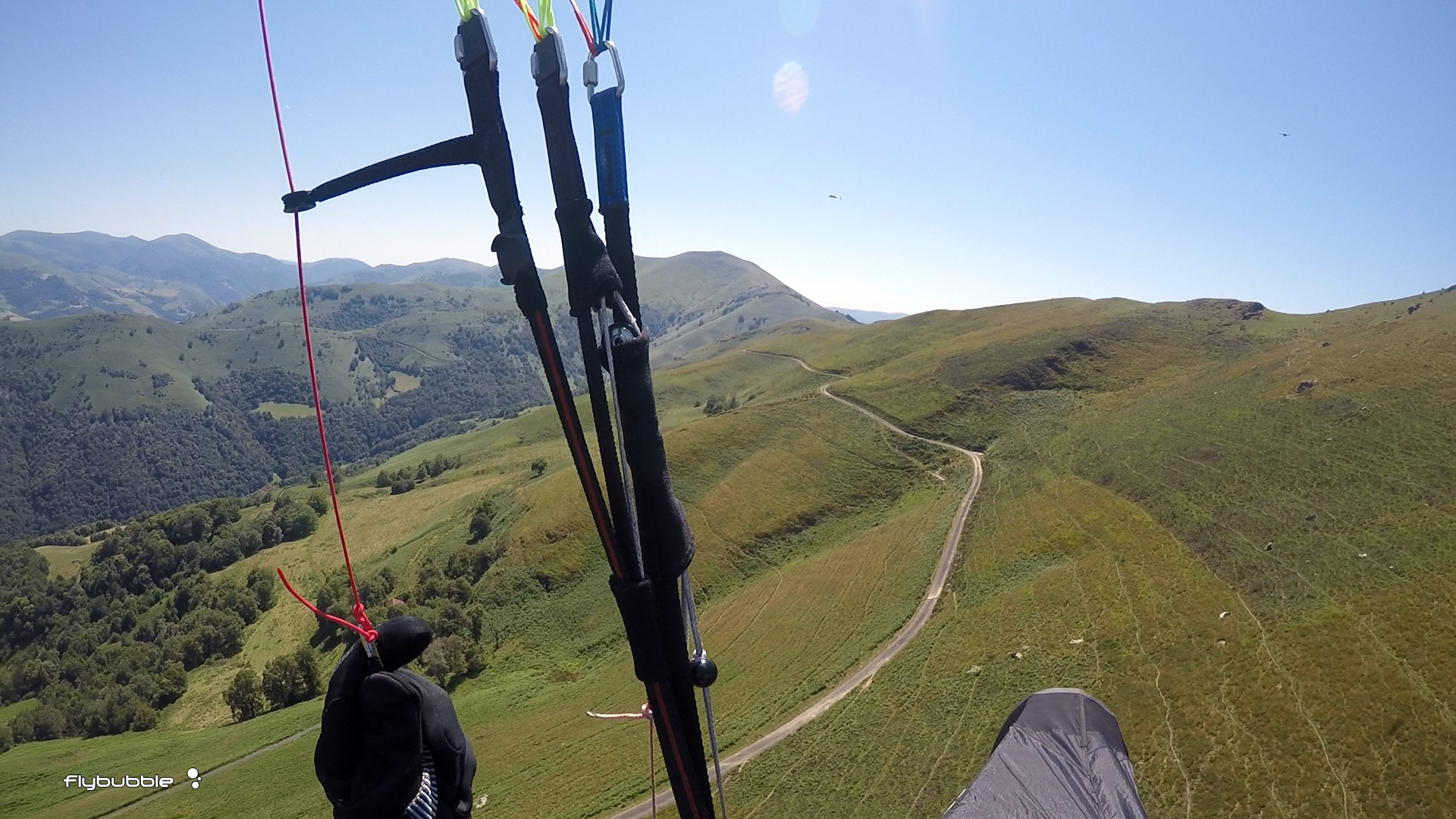
I'm jumping ahead of myself, carried away by the feats of faster pilots. At 15:30 I'm still near St Jean Pied a Port, but I've hiked around to a fantastic launch, and the wind has eased off! Felician and I join the vultures for some mild thermaling. Petz launches off the northern peak and crosses the valley to land near us on the next ridge in suddenly stable conditions. A hike and a hop and we're all at the base of the cols d'Iraty pass. I lose an hour here to have a swim in the river and recharge myself before the long ascent. It's still too damn hot.
At 18:00 Keller launches just before Ohri, avoiding the peak ascent. This is a move both Guede and Williams must have thought of, but the wind was still too strong for them. Keller joins the chase group in the Rio Subordan valley, closing in on Candanchu.

Back in the real world, I'm still hiking up the Cols d'Iraty pass, a 10km ascent of 800m, which the lead gaggle hiked up that morning. I know I'm a bit behind the leaders, but because I haven't checked live tracking I'm feeling happy with my performance on day 2 relative to those I could see nearby. I have no idea just how badly the leaders have beaten us, or how badly the weather will turn against us. By 21:30 I'd had enough of hiking, and join the Spanish team (Demetrio and his band of 7 merry supporters, all in a massive motorhome). They offer us a supper of mixed meats and bread. His feet are in a bad state, with blisters the width of his feet. But he's in a good mood, as am I. It's cooling down! We're going to fly tomorrow!
Hiking: 34km (2070m ascent)
Flying: 22km
XPYR Race: Day 3
The wind howled all night through the col, and sleeping in a pop-up tent became impossible. We didn't get much sleep, which just added to the accumulated fatigue from the heat, distance and short nights. So to break up the monotony of being slapped in the face by the tent, I rise early, have a quick breakfast, and start on the hike to Ohri, the promised land, where everything will change to flying, and I can be done with the endless slog.
It's about 14km with a 1000m ascent. Without the hiking app on my phone I'd have been lost on the overgrown trails.

Up ahead, at 10:00, Williams is at Anayet (TP3), and although he could have tried to follow the course line down to Formigal, he takes a decision to fly back on the course line and out of the Canfranc valley, to get in front of the high peaks. He passes over Mastromichele's head as he does so. His line is working.
By 11:00 I've passed Ohri (TP2)! I have pulled through the midfield some more. There are 7 of us at the turnpoint and another 4 a few km behind. The wind is screaming, so strong I don't even consider a flight. But Ludwig risks it and soars along the spine with single digit groundspeeds at low altitude. I'm amazed he's not whipped over the back into France. Nobody else is convinced it's safe. As it is, Ludwig only makes 6km, but it saves him the descent and is directly on the route to Izaba. He walks the rest of the day.
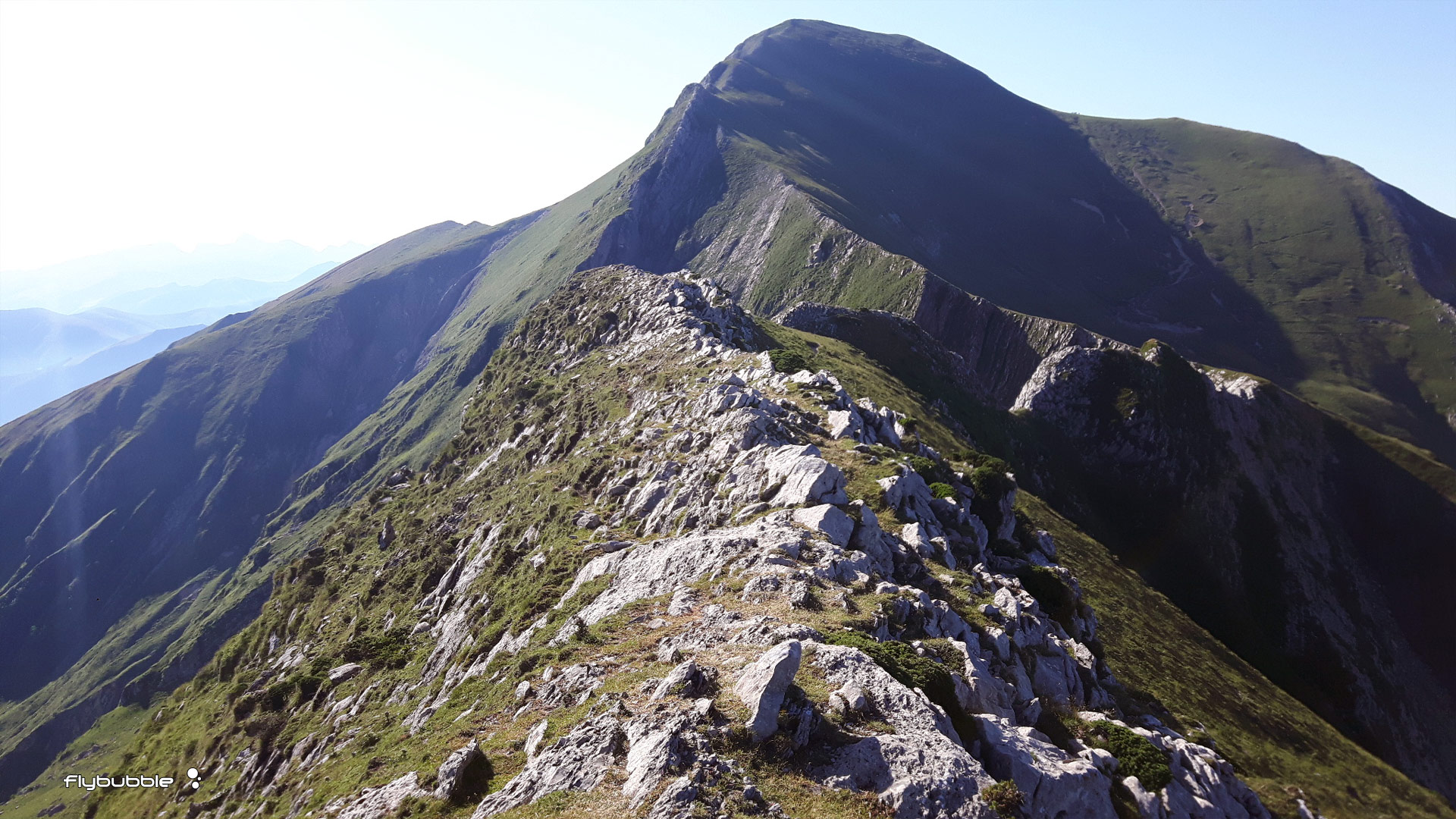
We won't fly now, but there's a big decision. Wait for possible flying (and let those other four catch us), or walk (and miss the flying if the wind drops).
It's so windy in the col, it's hard to conceive of nice flying conditions. I choose to walk down the road to Izaba. It's a 22km downhill hike in the heat of the day. By the end of it I am fatigued and need to stop 2 hours early to camp, wash and rest. At 17:40 the whole flock of pilots fly from Ohri, in light winds, and they all reach Izaba or go beyond (Ballon to south of high peaks, Gabiria to Tacheras).
It's like a knife through the heart. I made the wrong decision. I should have stopped, eaten, slept for 3 hours, and enjoyed a glorious cool glide. All my physical effort and good work to move through the pack, is wiped out. I'm a back-marker again. I break open my singular medicinal beer in our coolbox, then go to bed.
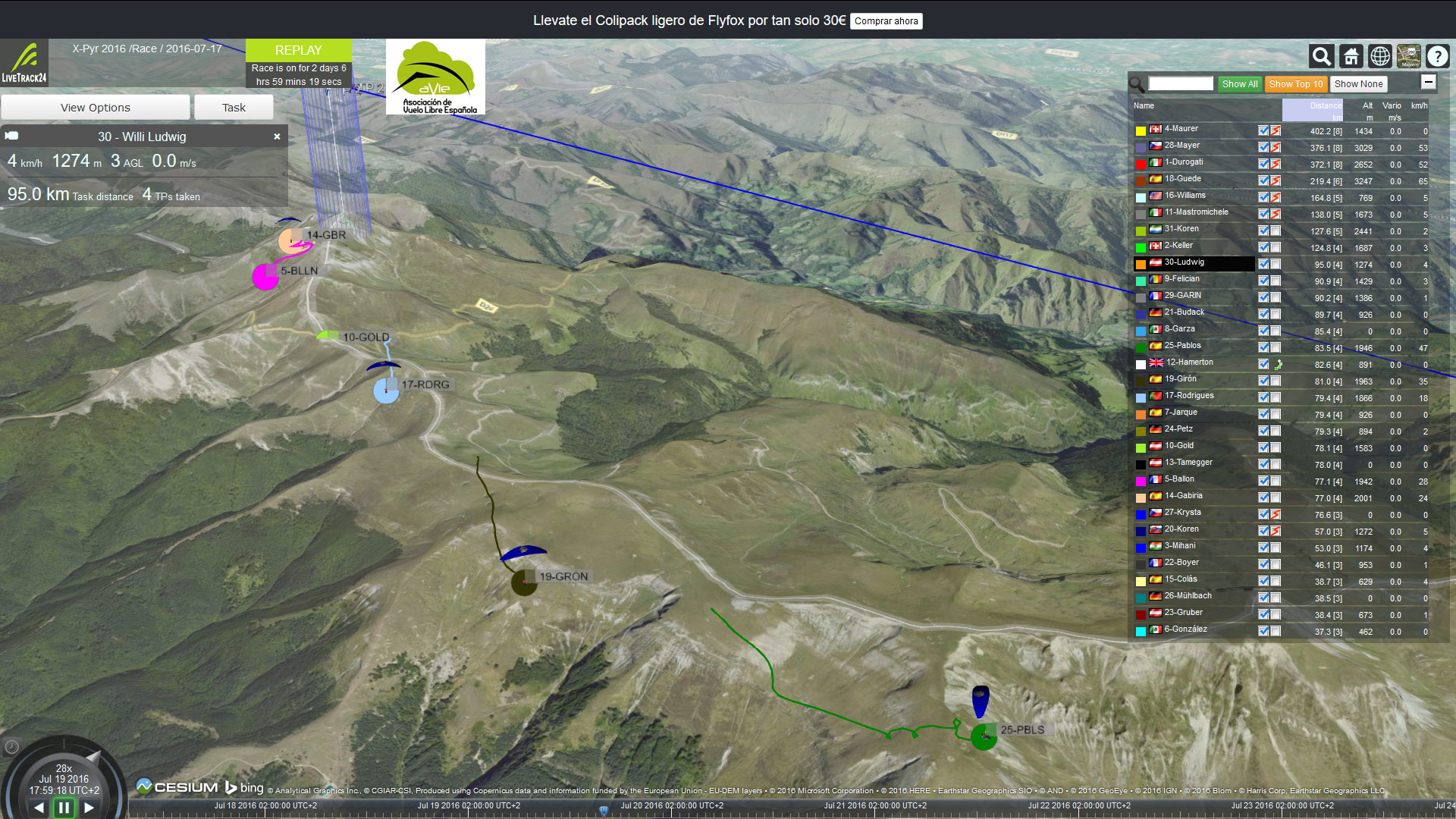
There are some more inspiring stories from the day. At 13:45 Williams relaunches off the front range: very good timing and repositioning. He gets up to 3200m, in fairly strong SW winds. Mastromichele has reached Anayet now. Although he flies, the going is tough in the back valley and he is put down fighting a strong headwind near Formigal (as is Juraj later), so Williams' decision was spot on. He hits a moderate headwind near Broto and patiently works the area for an hour before getting enough height to push forward and out on the main road leading to TP4. But it is Guede who flies the best here, launching from a peak near Biescas and pushing south early to avoid the Broto problem, making Pena Montanesa (TP4) at 16:30 and blazing through the high mountains to Cecire (TP5) reaching over 3700m and landing at 18:20. He really deserves his good placing.
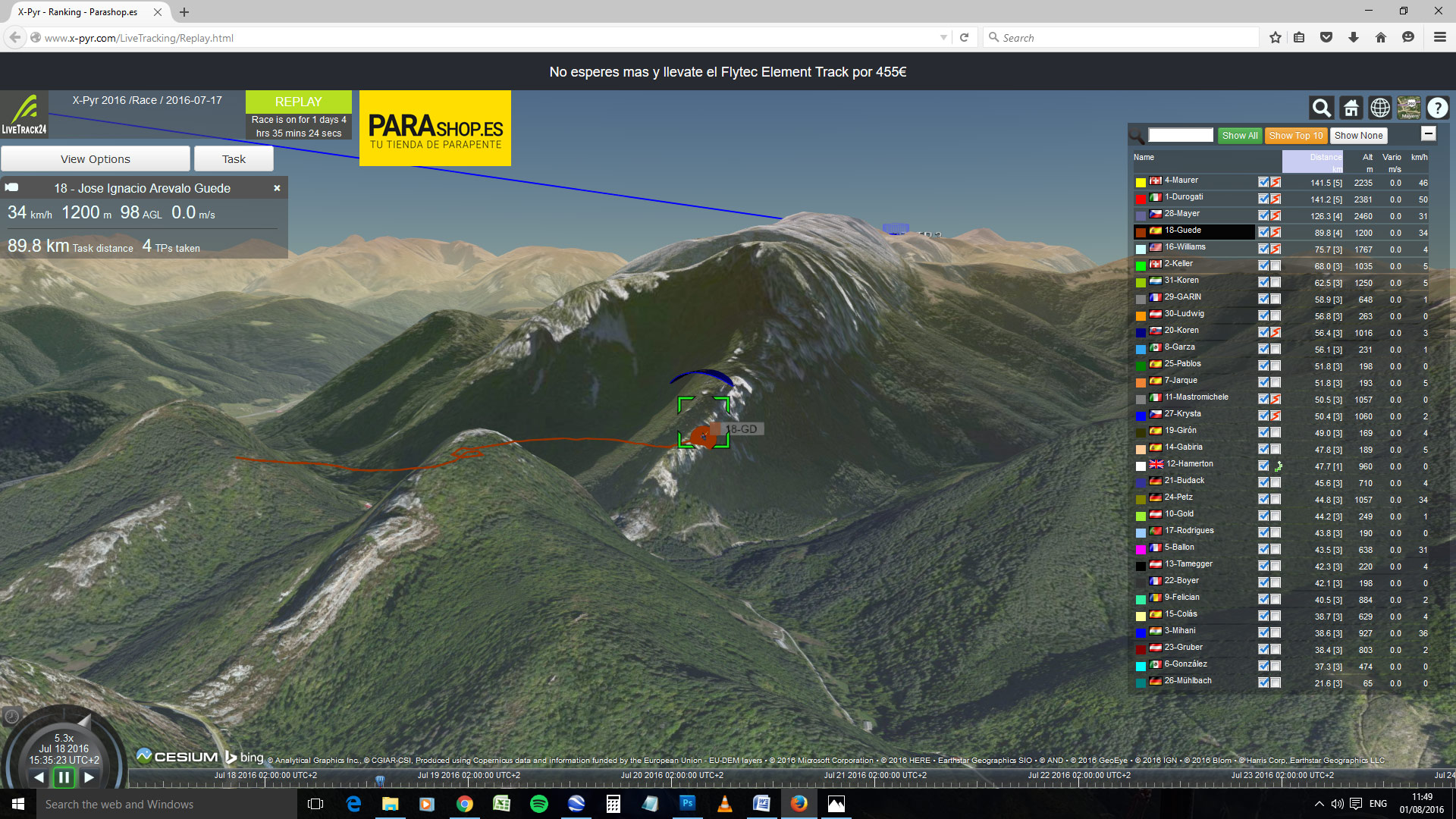
Guede made distance with some committed flying (Day 2 near Izaba)
Ahead of him, the trio of Maurer Durogati and Mayer have had their first day of separation. When Chrigel launches at 11:00, Mayer is less than 3km behind him, but Chrigel has chosen a slope facing more into the morning sun. By the time Mayer starts chasing him at 12:30, there's 30km between them, after Chrigel has done an aerial dance through the complex terrain.
Durogati is committed to the southern route and is far behind, near Castejon launch site. He also only starts chasing at 12:30. But testimony to their piloting skills, when they climb out after signing in at the Bergueda turnpoint (TP6) the gap is still only 30km. Then something exciting happens. Chrigel goes onto the north side of the Cadi mountains, gets stuck with poor climbs, misses the turnpoint cylinder, and finally he's forced to land high at 18:00. The hounds smell blood. Mayer and Durogati move in, hugging the south side of the Cadi mountain. Maurer is doing a desperate hike up the north side, he's in the turnpoint now, but Mayer has toplanded only 7km from the turnpoint, Durogati at 13km. It's tight!

But the flying window is about to shut. Chrigel launches from the top, hooks around the peak and glides directly down the course line towards goal. Mayer misses the window by a hair - he can't ascend high enough, fast enough, to get the turnpoint on foot and still glide down before the official 21h15 no-fly time. If he flies from where he is, he might miss the cylinder. One thermal would have made all the difference.
He camps at 2200m with Durogati, with no camping gear or food. The 30km separation to Chrigel is back again. They have an opportunity to fly in the morning, but thermals will only start near midday. If Chrigel can run the last 50km, he can grab the title.

Back near Izaba, the rest of us in the 'B' comp are no threat at all. We're half a country away.
Hiking: 36km (1000m ascent, 1780m descent)
Flying: 0
XPYR Race: Day 4
Although I start early, well rested, I am not clear with my supporter about the trail I'm heading for up the mountain and I have no coordinates for the trailhead. I lose an hour waiting for James (who has gone up another trail, with stuff I might want, if I fly). We then lose 3 hours and some leg power by going up to the peaks and returning, when a glance at the forecast would have shown unflyable conditions.
I must admit I found trying to forecast the flying conditions in an unfamiliar region with spotty roaming internet access on a phone too complicated while racing. Even the RASP forecasts, usually so accurate, seemed to be well off. Occasionally we received a useful weather overview from the race director, but my game plan was usually reduced to "walk up mountain, see conditions, fly or walk down". Contrast this with Maurer, who has his own meteorologist.

It was a walking day in our area, and the best route choice was taken by Felician, who stayed high on the ridge line (cooler), slept near refugio Belagua, and continued on the high ground on the course line without the big diversion down to Izaba. This advanced him through the field.
Maurer spent the morning running, and tagged the goal before 11:30, before the thermals began. Mayer and Durogati launched together at 12:45 but didn't fly much beyond where Chrigel flew the evening before, so it's a 5h30 run for Mayer, and a lot longer for Durogati, who is feeling ill.
I didn't bother running, because it was important to manage my enthusiasm, and although I could physically take more punishment, I know that running is much more exhausting than walking fast, so I only use it in emergencies. As it was, I was pretty depressed about my poor decisions and lack of flying. Although I was eating well (I counted four breakfasts on day 2, before I started on lunches), at some point all your body wants is sleep.

Greasy food fest: essential to keep the joints well oiled and motivation high
Despite early finishes and late starts, it was difficult to get enough sleep, because in my tired state it took longer to do everything necessary (eating, washing, packing, charging electronics, helping with camp management, stretching, finding misplaced items, updating blogs (mandatory) and planning on maps and trying to understand weather forecasts with a tired brain.) James was an incredible supporter so I had a great base to work from, he found us good overnight spots, set up sleeping quarters, cooked up proper meals, the cooler was always stocked, nothing broke down, and he found me fast all over the place. He also did more hiking up peaks than other teams, reducing my leg strain by carrying water and non-mandatory flying equipment (things like flying jacket, gloves, instruments and food). Over a week of peak ascents and daily marathons, it makes a difference.

Here's my favourite lunch break and typical of the race. James cruises past somewhere on some lonely stretch of hiking, at about the point where it is turning from spectacular scenery into an exhausting blur of stupid trees and horrible high peaks. "See you in 3k?" OK. Half an hour, I can do that. I grind on uphill. I round a random corner, and there in the shade is the C4, camp kitchen open. I collapse on a mattress and steal a quick power nap.
"Lunch time!" In my face is a gastronomic wonderwork. A fried pork burger with a runny egg on top, stuffed into some kind of bread thing with salty crisps and avocado, and a bottle of coke to wash it down. I attack it. When I hit the road again, the miles fly by. Up a hill, down a hill, doesn't matter now, the legs just keep on moving.
The weather is drawing in, the thunderstorm cells that have been blowing over from the west all day are growing larger. There'll be rain soon, a lot of it.
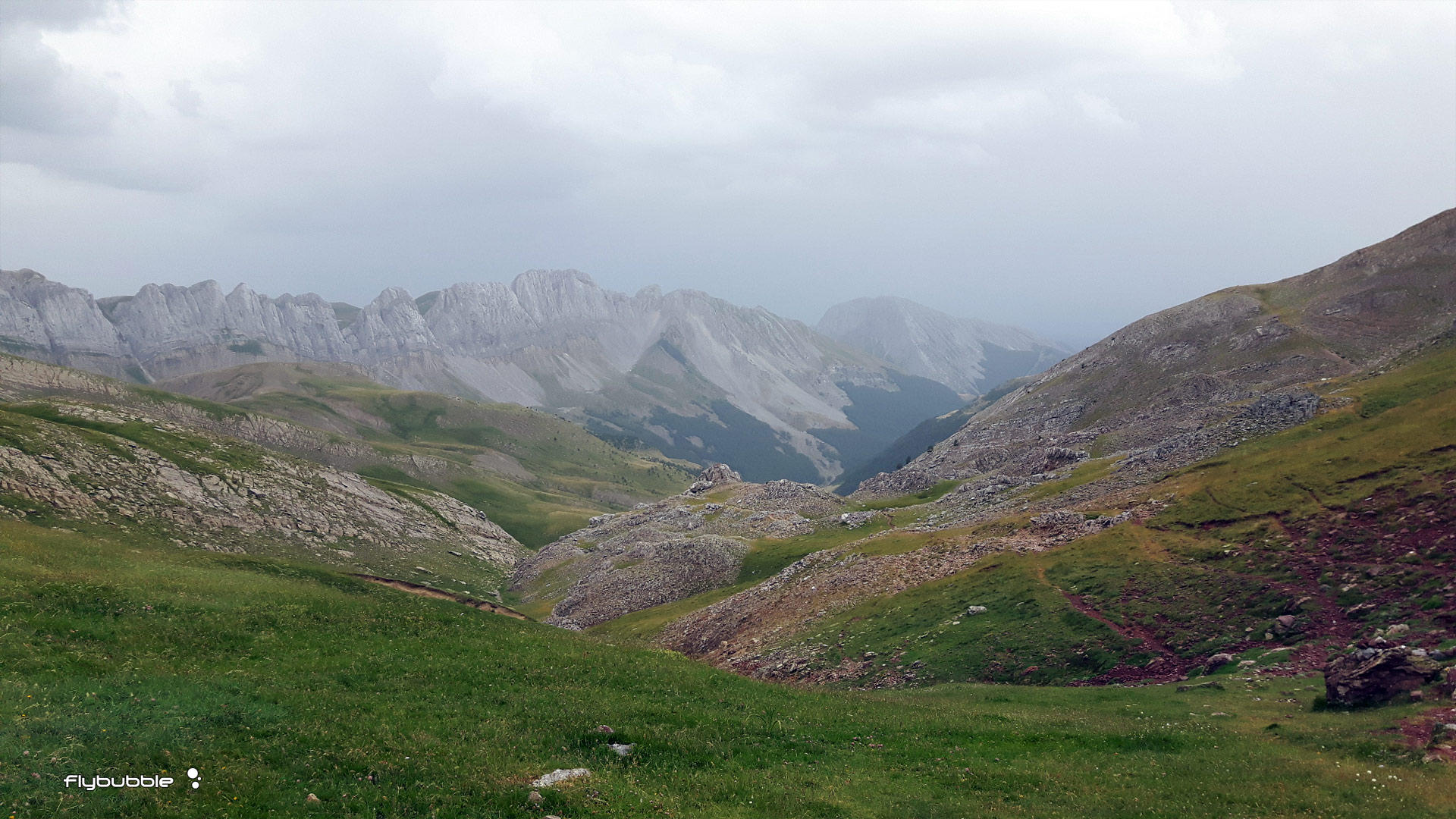
I push on. Looking back at the replay, I see there was another option. Camp, rest, and walk south in the morning with Pablos, who flew the next day and avoided three peak ascents and uncountable kilometres on the ground. It's so hard to do this, to wait, after a whole day of effort to get ahead.
I kept my momentum up and over the col to the Rio Subordan valley. Again, I missed a fork that went to a flying site (Ballon hiked south). I had turnpoint fixation. The straight route followed a gravel road, to our camp at the roadhead. I knew this place, I knew the hike ahead, and felt I could do it in time for flying tomorrow from the turnpoint.

Hiking: 36km (1820m ascent, 1235m descent)
Flying: 0
XPYR Race: Day 5
We get going early, and James joins me for the first hour. It's a wonderful hike, in the best landscape, like something out of Clan of the Cave Bear. There are barrows from 3000 BC strewn around the valley. Above the dramatic skyline there are wave clouds, so I don't even think about flying ... but again, there were pilots with more optimism than I, who were aiming for their personal peaks.

Ballon, who hiked with me over col the previous evening, hiked down to Hecho (with a leisurely 08:00 start) instead of up the Rio Subordan valley. He reached a launch site at 12:00. He flew over me, got TP3 then backtracked to get out of valley and avoid the Panticosa pit. He came around the south side and passed many pilots. Unfortunately he blew his flight by entering Monte Perdido airspace near TP4. Pablos also flew this section, launching further back, south-east of Zuriza.
I reached the base of Anayet trail at 13:45 (after 20km with 800m ascent and 700m descent, so my legs are worked). The clouds are building rapidly. Rain forecast for later, there's a big peak to ascend, pilots are flying overhead, and I'm right down down down in the valley. It seems like I've blown the day and I feel overwhelmed.
The group I was identifying with, the back pack, have already gone over the turnpoint and are in the Panticosa valley. I could have walked up to the turnpoint and reached it before 18:00, but I didn't like the weather risk and couldn't see the benefit in doing this as the flight was very unlikely, so I'd have to hike down the other side, then up another peak in the morning. I'd just had the folly of this demonstrated to me by Pablos and Ballon, who went faster by going slower.

But it seemed silly to just stop racing. I looked for something creative to do. I went to a really dumb option nearby, lost time waiting for nice(r) launch conditions, scared myself on full bar in valley wind wash, got spanked behind a spine, and landed at 15:45. I would have been better off posting photos of my feet on Facebook.
I could have hiked up the spine I was aiming for, much safer and possibly successful. If I'd had the energy. I hit a low. The adrenalin from flying in the turbulent windy channel had drained my strength completely. Time to check into the hotel Santacristina for a recharge; probably my best decision of the race.
That night it absolutely hammered down with rain and thunderstorms. Lightning flashed continuously for three minutes at a time, before brief dark periods.
"I think Keller and Koren are having a bit of a different experience to us," I joked to James.
"That roasted rabbit looked nice," James replied. "The wine was good too."

We sank down into the soft sheets, and I dreamt of Chrigel being washed out to sea, away from goal. But he found a desert island, launched off the beach, soared over the waves and flew like an albatross back to Port de la Selba anyway.
Total hiking: 21km (800m ascent, 700m descent)
Total flying: 1km
XPYR Race: Day 6
Hotel breakfast was included, and only available from 08:00. I didn't need much convincing to have a lie in. When I returned from the serving table with my 4th breakfast the waiter had cleared my table away. OK, time to go, I suppose. Somewhere out there, the XPYR is going on, despite the unclear forecasts and persistent rain.
Ahead of me at 09:00, Felician is getting ready to glide down past Broto from a hiked peak. Pablos hikes further south on the ridge line, gets a better glide at 10:00 and positions himself on the main road to TP4. Gabiria and Giron have a short glide at 11:30. Surprisingly, nobody gets a flight in again after that in the area approaching TP4.
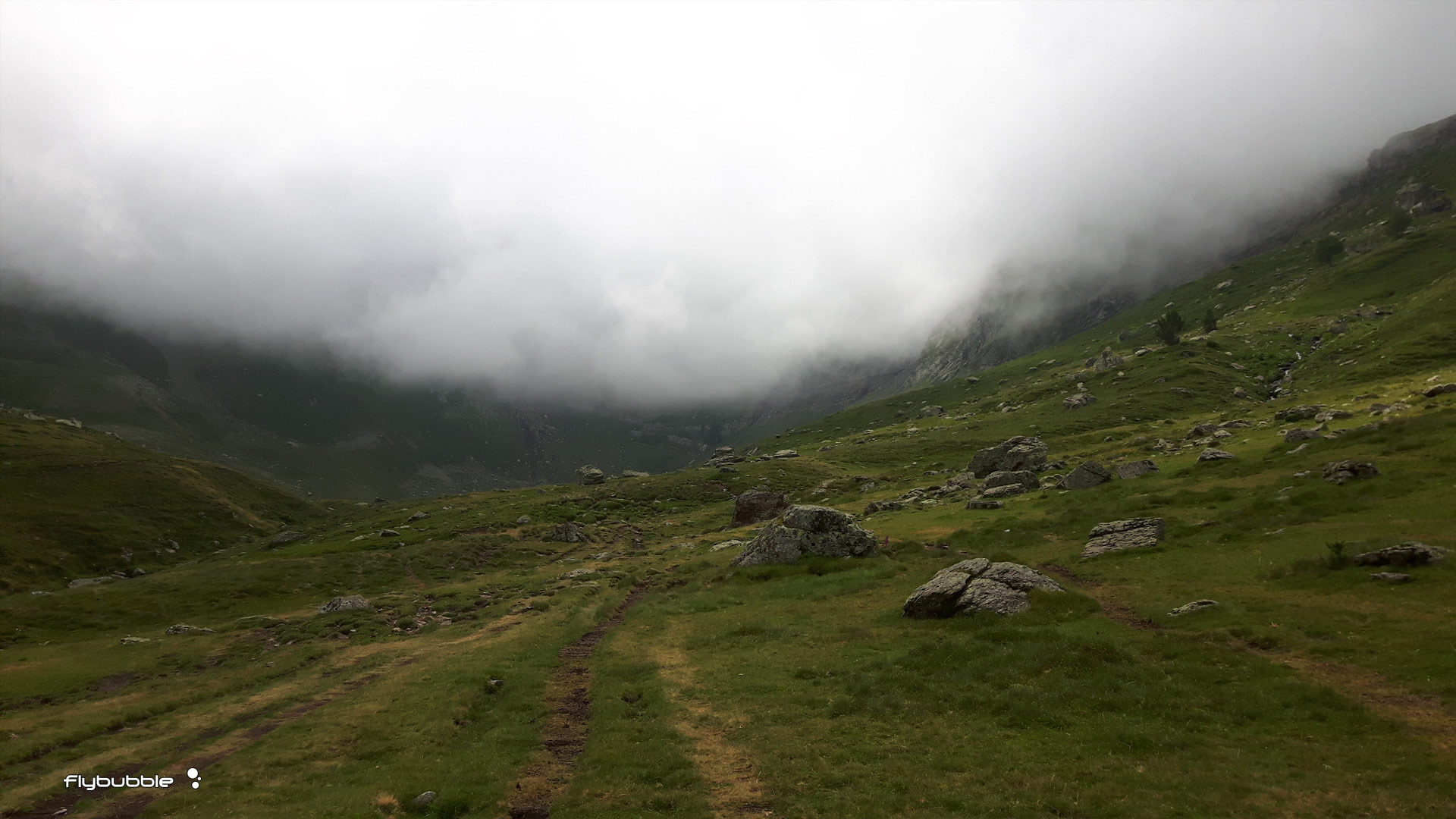
I hiked up to Anayet, just for the love of it. My race pace had gone, it was purely a pleasure trip, to conquer the peak that had blocked my way, and to go into new territory. I was right about the timing, I launched at 14:45 from Pic de Garganta. If I'd tried it the day before, I would have been caught high in the rain and the dark.
The conditions seem OK when I launch. Light wind, some wispy cloud, with a bit of the northerly poking over the pass. Gliding down made sense.
As I emerged from my sheltered channel in the high peaks, I realised my error. The northerly was pouring down over the pass and washing down the valley towards Formigal. Very soon I was on speedbar, crabbing across the terrain against the 30-35km/h flow. I worked every scrap of lift I could find, to give me time to drift further away from the pass. It seemed possible for me to reach the better Spanish air, marked by puffy cumulus clouds, at the end of the valley.
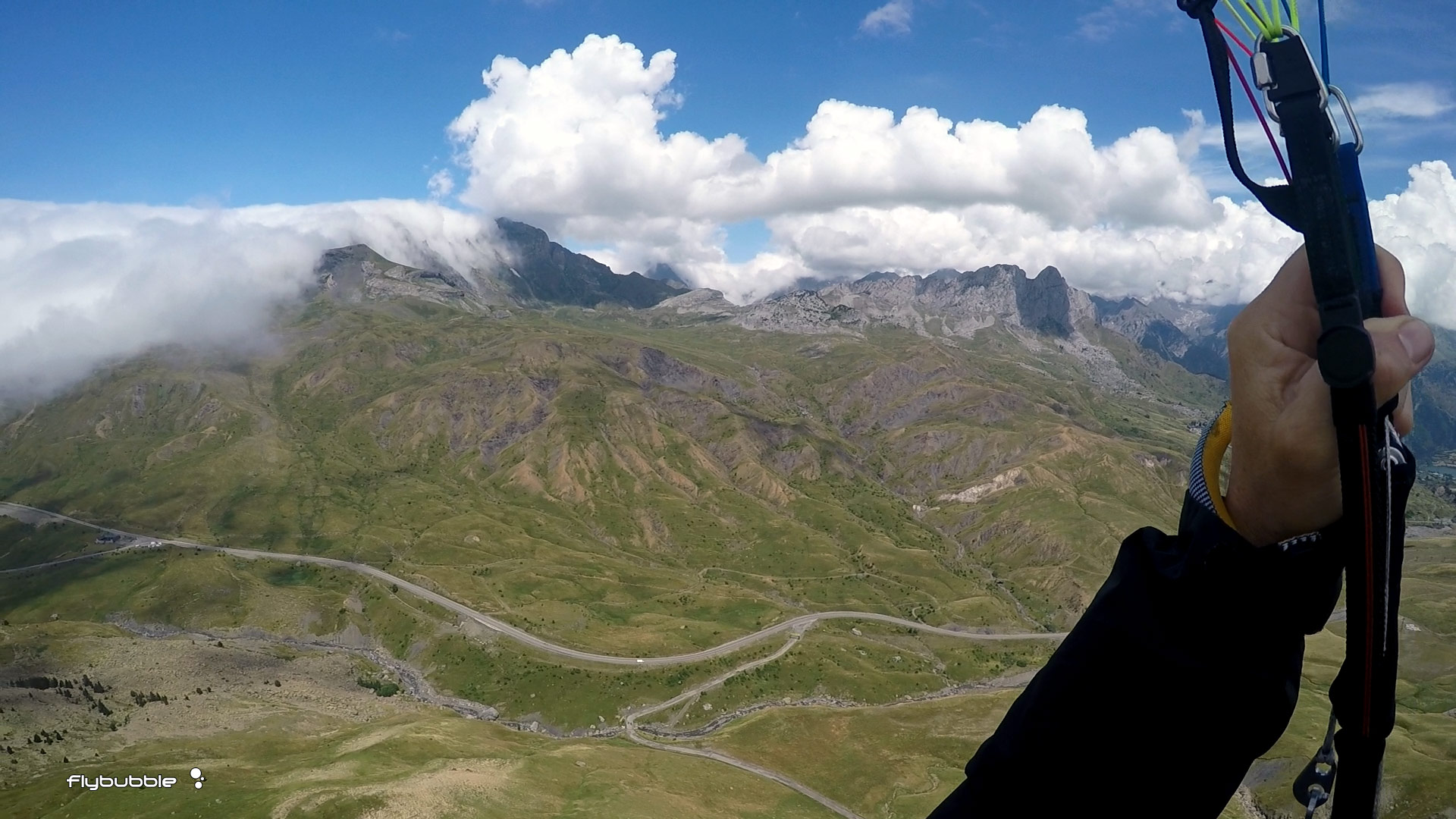
As I rode the flow down the terrain, the windspeed increased, and the valley became constricted. There was a blind corner which I couldn't go around without more height, but the thermals were shredded, then there was just turbulence. I chose the safest landing zone I could see, some sloping fields downwind of the lake, where the wind would hopefully be smoothest and weakest.
Over the lake, I parked into wind on speedbar, watching the gusts tear at the water. This was going to be wild. I stayed over water for as long as possible, then swung around to the landing field. The air was rough, and very lifty. I set up too far back in the field, got pinned in strong wind and lift, and drilled the speedbar and big ears to get in fast before the approaching squall. This was too much for my wing, combined with the wind shear close to the ground, and a kick of turbulence. I stalled the last 10m and was swung sideways into the only rock in the field. Bang, hip landing, my first in 24 years of flying. Bad pilot. Silly pilot. Lucky pilot.

The field belonged to a Spanish family who were delighted to have a stranger drop out of the sky, and they rewarded my appearance by dragging me into the family paella festivities. Beer, coffee and brandies included. What a bonus! The XPYR is full of surprises.
I want to get away from this horrid northerly wind. Ignoring the complaints from my bruised hip, I put in a 17km hike to get down to Biescas for a better chance tomorrow. On the way, I pass the Spanish acro champs at Panticosa, which are amusing to watch for the way the acro wings are being taken to pieces by the turbulent wind. It's all a big joke for them, as they land in the water and are fished out by the rescue boat.
Hiking: 27km (1000m ascent, 700m descent)
Total flying: 8km
XPYR Race: Day 7
It's the final day, and it's the best flying forecast I've seen all week. James hikes up with me to a perfect launch site; a long steady hike through the forest. We take in the amazing views, watch the vultures start to thermal, and I lob James off the top on his Advance Pi 2 to see what the air is like. There are some thermals, and some signs of the northerly wind near the valley. All good, it will help me on my way. I'm glad James has finally had an opportunity to fly; it's been a full-on week for him with little rest.
For once, I have time to calm myself on launch, take in the world, and find my flying focus. I launch at 13:00 straight into a thermal cycle, climb to cloudbase in a 5 up, and glide past the special panoramic view. I catch and pass Gabiria and Giron, positioned on a peak with less shelter from the northerly.

Things are going well, but I can see the XC route I should fly is out into the Spanish plains; the course turns northeast from the turnpoint, straight into the horrid wind spilling down over the divide. Ludwig launches on the leeside of the turnpoint and gets drilled trying to round it, so flying beyond the turnpoint into the shelter of Pena Montenesa is not going to work with this wind.
So it's onto full bar again and try to find the safest landing in the windy valley. At least this one is wide and there's a nice riverbed. I touch down and pack up fast. Gabiria and Giron come sailing overhead, but despite their height advantage they get stopped and land nearby. Even Rodrigues, who pulls off an impressive flight from Anayet and comes by with another 500m altitude, lands in the same place, blocked completely by the wind.

It's going to be a hiking race to the 10:30 finish tonight. I set off up the final peak to bag the turnpoint. It seems there are limited trails over the back, the only way to advance will be to walk a huge loop out to the west to get to where Budack and Ludwig are on the road to France.
I could have done without the hip injury. This piece was ideal for running, a long descent followed by a gradual ascent, into the cooling night. I might have put some pressure on the others. As it was, I had to walk at full tilt to get past Rodrigues, who had taken a sneaky line straight over the back into the un-navigable canyons and forests, where he became stuck in the dark and had to sleep in his wing overnight. That's dedication for you.
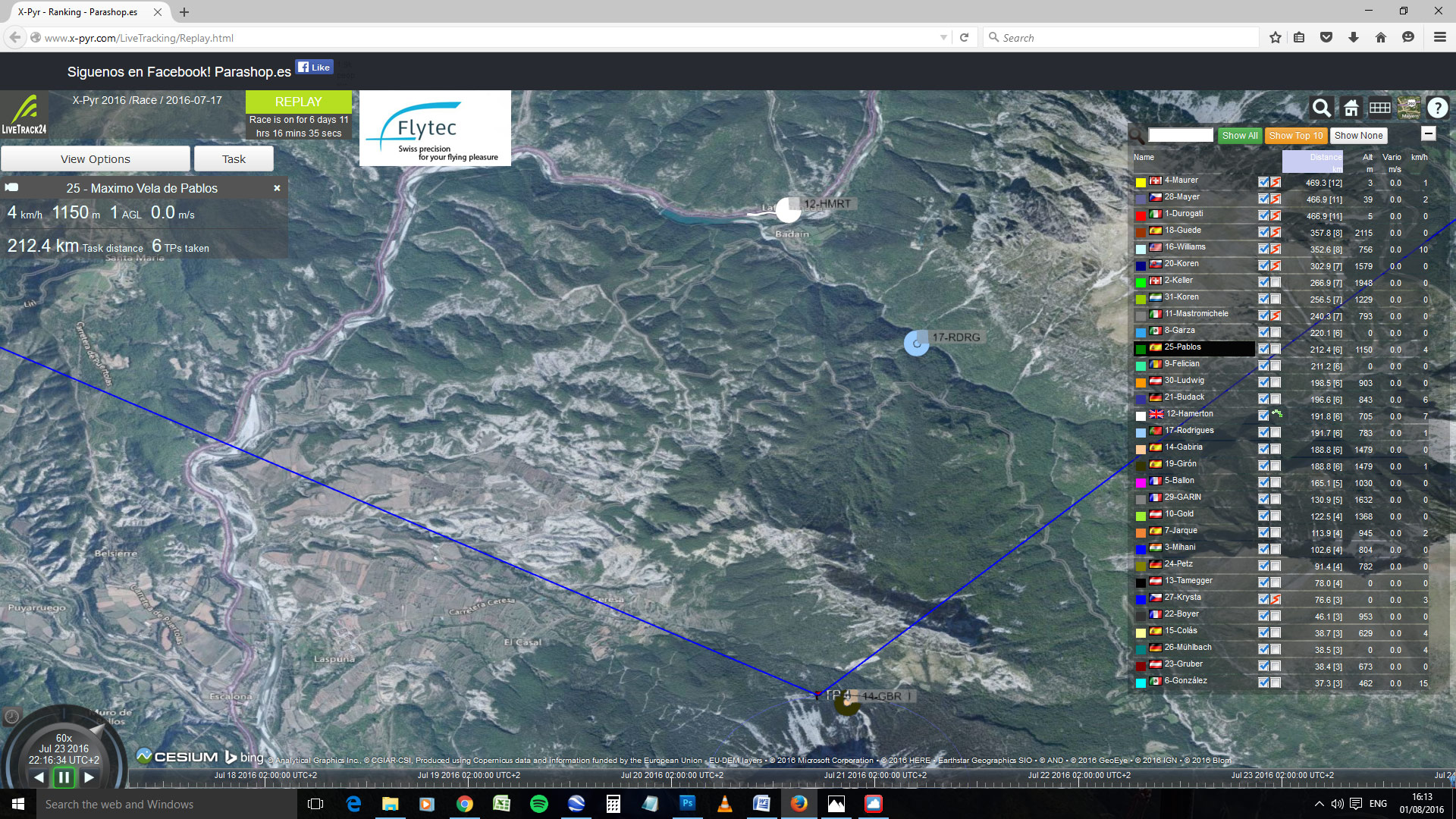
As I strode into 15th position at 22:20 I had to laugh at the absurdity of it all. We race for seven days with different lines, different advantages, different opportunities and equipment, and it comes down to an egg-and-spoon race in the dark on a few kilometres of tar road. I'd made some big mistakes, but so had everyone else. I'd given 100%, but so had everyone else. I had very limited flying in very challenging conditions. So had everyone else. And the prize for those who were truly prepared and fast on their feet was two days of cracking good flying conditions.
Hiking: 35km (2200m ascent, 600m descent)
Flying: 37km
So all it meant for me was that more training was required for next time. More mountain running, more mobile mountain weather forecasting, and above all, more mountain flying.
It was hot, it was tough, it was intense and epic, but I'll be back. I have unfinished business in the Pyrenees. The XPYR is an elite offshoot of a crazy sport but it's utterly unique and set in a spectacular arena. I'm glad to have been a part of the 2016 edition.
.jpg)
Thanks to Flybubble for their support, James Hope Lang for being my wingman, Inigo and the XPYR team for the organisation, and the many event sponsors for their generosity.
Total XPYR hiking (7days): 218km
Total XPYR flying (7 days): 76km
Other stories
As a competitor on the XPYR 2016, my race report is unavoidably myopic. I had very little idea of what challenges my competitors were facing: I was consumed by my own. I've done my best to share some of the action, but the real story of the race will only emerge as other pilots tell their tales.
Eduardo Garza (Team Mexico) sums the event up perfectly: "It's been a long journey since we decided to participate in the 2016 edition of the X-Pyr. We knew this competition was a challenge from the very moment we made the decision to send the registration form. Ever since, it has been a non-stop challenge both physically and mentally; research, planning, studying, analyzing, reading, flying and training hours upon hours at the gym, on the road and on the mountain…all this has been a unique experience by itself.
Now that we have spent so much time here in the playground of the wonderful and spectacular Pyrenees mountain range we realize how impressive and brutal the task really is. Still, the more you hike and fly through the way-points the more you learn to respect and love the place. In addition, we can’t forget to mention how wonderful and helpful the organization has been since the beginning. It’s been fun to meet Íñigo & Co. and see his passion and dedication for this project. In addition, food is great, people are friendly and in overall this has been an exceptional experience."

I look forward to reading the many pilot reports.
More stories on the XPYR website.
Brought to you by Flybubble
Want to see more? There’s no better way to support our efforts than buying from us. We’ll ensure you get great service! Choose from our great range AND enable us to produce more content to benefit the freeflight community.

